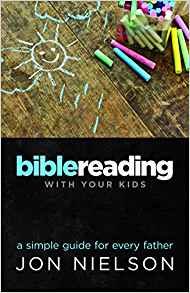This chapter is short and to the (four) point(s)! Having dealt with the theological foundation in chapter one, Nielson moves into some practical foundations.

I must admit at the outset, I struggle to consistently read the Bible with my own three children. Life is crazy, I am gone one, two or three nights of the week, and the needs of a one-year old differ greatly from those of girls who are six and eight. My wife and I aim to saturate our home with Scripture, but often nowadays that comes in occasions of sadness, shame, discipline and follow-up to school events. Those are good and right, but would be better grounded in the more systematic reading of the Bible and/or a Bible storybook, which has happened—on occasion—in the past. I assume from experience and anecdote that is where most of us are at.
Nielson’s first point is the fatherhood factor. He references the results of a 1994 report from Switzerland that serves to illustrate the generally true statement that a father’s spiritual impact on his family is the deepest one. This may sound politically incorrect, but I think we all know that this rings true.
The second foundation is the relationship factor. I am most impacted by this point, in which Nielson emphasizes the reality of family relationships and conversations revolving around the Bible. In a time and place where spiritual conversations are harder and more awkward to initiate, he argues that Bible reading can and will lead to a more natural “rhythm” of understanding issues in our lives being primarily addressed in the Bible.
Foundation three is the capacity factor. Nielson here challenges our assumptions about what children can understand an early age, and urges us to raise the bar. Indeed, this is a good word: let’s raise the bar! I have this unknown quote written in my office: “Remember, students learning trigonometry in high school can handle theology in church.” That’s right, isn’t it? Can kids who are learning to read and memorizing times tables begin to see what Jesus means when he speaks of loving God and loving neighbor? Can children learning piano and guitar and trumpet also start to ponder what it means that God created humans as male and female? Yes, I think they can. In fact, I know they can! Nielson includes a great anecdote from his family’s devotions too.
Nielson ends with the relevance factor. He argues quickly and persuasively the Bible speaks precisely to the things are children wrestle with: anxiety, gender and sexuality are his examples. We could also easily mention obedience and submission to authorities, friendship and gossip. This point should be one we treasure: the Bible—never so easily accessible as it is today—offers answers to life’s mundane and biggest questions! Parents have a resource to go to, and it is one we can also point our kids to: God’s very word!
These should be good reminders for many of us, good introductions to others. Whatever the case, parents, children’s and youth workers, grandparents, uncles and aunts all can apply these practical foundations to our reason for reading the Bible with the children God has placed in our care. So let’s consider and do this in whatever ways we can, both small and large, right now! God is with us and he has given us what we need!
– Pastor Andrew
